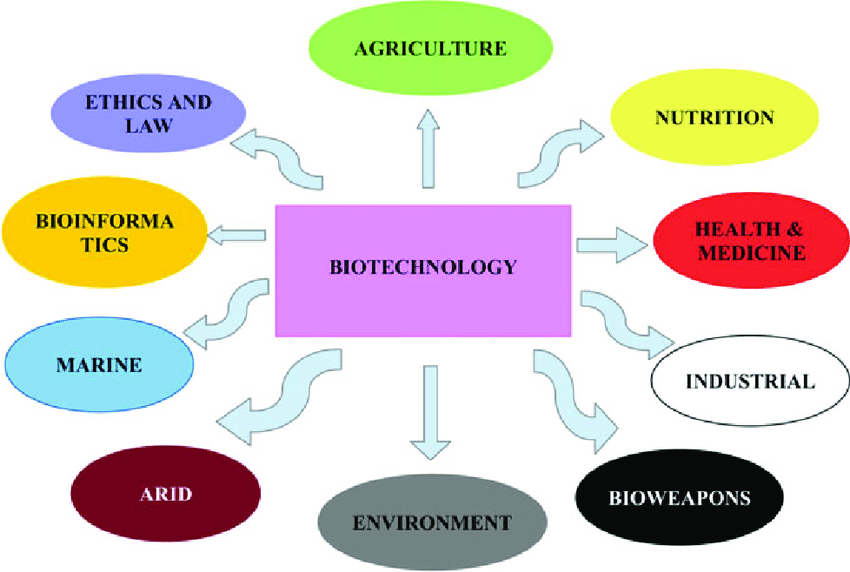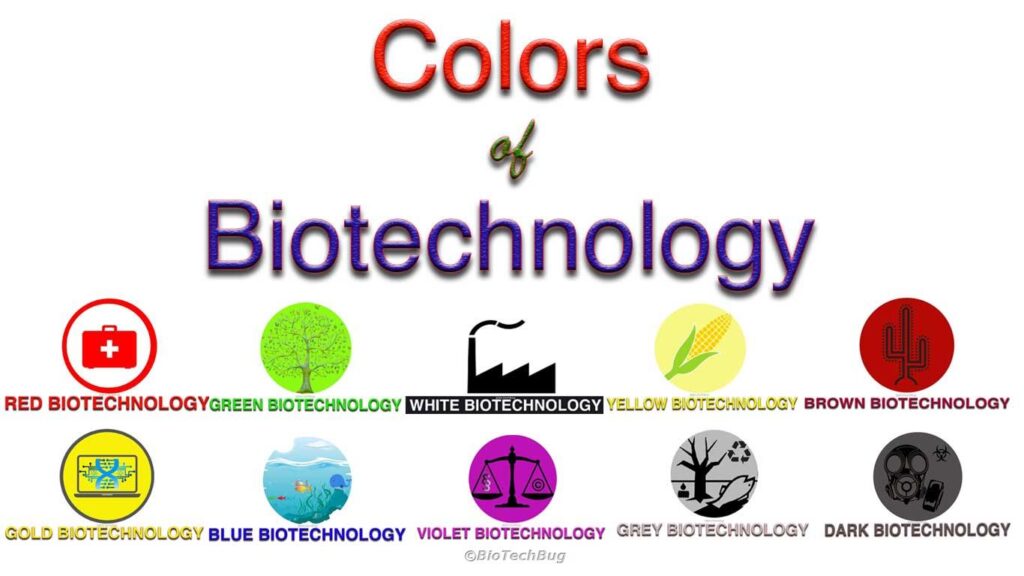Biotechnology encompasses diverse sectors, each represented by a specific color. Red biotechnology focuses on medical advancements like pharmaceuticals and gene therapy. Green biotechnology deals with agricultural innovations such as genetically modified crops. White biotechnology involves industrial applications, including biofuels and bioplastics.
Blue biotechnology explores marine resources for pharmaceuticals. Yellow biotechnology enhances food production and safety. Grey biotechnology focuses on environmental solutions like bioremediation. Brown biotechnology addresses arid land agriculture. Purple biotechnology deals with ethical and societal issues. Gold biotechnology integrates bioinformatics and big data.
Black biotechnology involves bioterrorism defense. Orange biotechnology promotes biotech education, and violet biotechnology ensures regulatory compliance. These colors illustrate biotechnology’s diverse and significant impacts across various fields.
Genetic Engineering Green:

Genetic engineering is perhaps the most recognizable hue in the biotech spectrum. It involves manipulating the genetic material of organisms to alter their traits or behaviors, often through techniques like gene editing using CRISPR-Cas9 or recombinant DNA technology.
This color symbolizes the power to reshape life at its most fundamental level, offering possibilities for disease eradication, agricultural improvement, and even the creation of bioengineered organisms tailored for specific purposes.
Genetic engineering has led to breakthroughs such as Golden Rice, which is fortified with vitamin A, and the development of transgenic animals for research and therapeutic protein production.
Diagnostic Yellow
Yellow symbolizes the light shed by diagnostic techniques in biotechnology. From PCR (Polymerase Chain Reaction) to ELISA (Enzyme-Linked Immunosorbent Assay), diagnostic tools empower scientists to detect diseases, monitor health, and track environmental factors with precision.
This color represents the pivotal role of diagnostics in early disease detection, personalized medicine, and epidemiological surveillance, highlighting the importance of accurate and rapid testing in healthcare and beyond.
Advances in diagnostic technology have revolutionized fields like oncology, with liquid biopsies enabling non-invasive cancer detection and monitoring, and infectious disease management, where rapid diagnostic tests can curb outbreaks by identifying pathogens swiftly.
Therapeutic Blue
Blue represents the therapeutic applications of biotechnology, encompassing the development of novel drugs, gene therapies, and regenerative medicine. Biopharmaceuticals, such as monoclonal antibodies and vaccines, exemplify the therapeutic potential of biotech innovations.
This color symbolizes hope for patients battling diseases ranging from cancer to genetic disorders, illustrating how biotechnology continues to push the boundaries of medicine and improve quality of life worldwide.
Examples include CAR-T cell therapy for cancer treatment, where a patient’s T cells are engineered to target and destroy cancer cells, and mRNA vaccines, which have shown their efficacy and adaptability during the COVID-19 pandemic.
Industrial Cyan
Industrial biotechnology, often depicted in cyan, focuses on using biological systems to produce industrial goods and processes sustainably. This includes biofuels, bioplastics, and enzymes used in manufacturing, offering eco-friendly alternatives to conventional methods.
Cyan represents the intersection of biology and industry, where microbes and enzymes become catalysts for sustainable production, reducing reliance on fossil fuels and minimizing environmental impact.
Innovations in this field include the development of biodegradable plastics from microbial fermentation processes, and bioethanol production from agricultural waste, providing renewable energy sources and reducing greenhouse gas emissions.
Agricultural Green
Agricultural biotechnology, akin to a lush green, explores genetic modification and breeding techniques to enhance crop yields, nutritional content, and resistance to pests and diseases. Genetically modified crops are a prime example of how biotech can address global food security challenges.
Green symbolizes the promise of biotechnology to feed a growing population while minimizing the ecological footprint of agriculture, fostering resilience in the face of climate change and resource scarcity.
Key developments include drought-resistant crops that can withstand changing climate conditions, and biofortified crops like iron-enriched beans and zinc-fortified wheat, addressing micronutrient deficiencies in developing regions.
Environmental Olive
Olive hues represent bioremediation and environmental biotechnology, which aim to mitigate pollution and restore ecosystems using biological agents. Microorganisms and plants are leveraged to clean up contaminated soil, water, and air, showcasing nature’s resilience with a biotechnological assist.
Olive symbolizes the harmonious interaction between technology and ecology, where biotechnology becomes a tool for environmental stewardship, preserving biodiversity and safeguarding the planet for future generations.
Notable applications include the use of genetically engineered bacteria to break down oil spills, phytoremediation techniques using plants to extract heavy metals from polluted soils, and the development of biosensors for detecting environmental contaminants.
Bioinformatics Gray
Bioinformatics, often depicted in shades of gray, is the interdisciplinary field that combines biology, computer science, and statistics to analyze and interpret biological data. From genomic sequencing to protein structure prediction, bioinformatics plays a pivotal role in deciphering the complexities of living systems.
Gray symbolizes the vast data landscape that bioinformatics navigates, where algorithms and computational tools unravel the mysteries encoded in the genome, transcriptome, and beyond, driving discoveries in medicine, agriculture, and evolutionary biology.
The Human Genome Project, which mapped the entire human genome, exemplifies the power of bioinformatics in understanding genetic blueprints, while recent advancements in artificial intelligence and machine learning are enhancing the predictive capabilities of bioinformatics tools in drug discovery and precision medicine.
Synthetic Biology Magenta
Synthetic biology, with its visionary quest to engineer novel biological systems and organisms, radiates in shades of magenta. By designing genetic circuits, metabolic pathways, and even artificial life forms, synthetic biologists aim to revolutionize industries, create new materials, and unlock the secrets of life.
Magenta symbolizes the creativity and ambition of synthetic biology, where scientists become architects of biology, sculpting living systems with precision and purpose, blurring the lines between nature and technology.
This field has produced synthetic organisms capable of producing pharmaceuticals, biofuels, and specialty chemicals, as well as groundbreaking work in creating minimal cell genomes that explore the essential requirements for life.
Nanobiotechnology Silver
Nanobiotechnology, shimmering like silver, merges nanotechnology with biotechnology to create innovative solutions at the nanoscale. Nano-sized particles, sensors, and delivery systems hold promise in targeted drug delivery, imaging, and diagnostics, pushing the boundaries of precision medicine.
Silver symbolizes the transformative potential of nanobiotechnology, where tiny structures interact with biological systems with exquisite control, opening new frontiers in healthcare, materials science, and beyond.
Applications include nanoparticle-based drug delivery systems that enhance the efficacy and reduce the side effects of chemotherapy, nanosensors that can detect biomarkers for early disease diagnosis, and nanomaterials used in tissue engineering and regenerative medicine.
Stem Cell Gold
Stem cell research, akin to a precious gold, holds immense potential in regenerative medicine and tissue engineering. Stem cells, with their remarkable ability to differentiate into various cell types, offer hope for treating injuries, degenerative diseases, and even growing organs for transplantation.
Gold symbolizes the regenerative power of stem cells, where biological alchemy transforms injury into healing, aging into rejuvenation, and illness into health, ushering in a new era of personalized regenerative therapies.
Pioneering work in this field includes the development of induced pluripotent stem cells (iPSCs), which can be generated from adult cells and reprogrammed to become any cell type, and the use of stem cells in repairing damaged heart tissue after a myocardial infarction.
Neurotechnology Violet
Violet hues symbolize neurotechnology, which explores the interface between biology and the nervous system. From brain-computer interfaces to neural implants and neuropharmacology, advancements in this field hold promise for understanding cognition, treating neurological disorders, and augmenting human capabilities.
Violet symbolizes the enigmatic nature of the brain, where technology becomes a window into the mind, enhancing human potential and reshaping our understanding of consciousness, memory, and identity.
Breakthroughs include deep brain stimulation for treating Parkinson’s disease and depression, brain-machine interfaces that enable paralyzed individuals to control prosthetic limbs with their thoughts, and neuroprosthetics that restore sensory functions.
Ethics and Regulation White:
Finally, the color white represents the ethical and regulatory framework that guides the responsible practice of biotechnology. Ethical considerations surrounding issues like genetic privacy, equitable access to biotech innovations, and the implications of synthetic life forms are essential to ensure that biotechnology serves the greater good.
White symbolizes the transparency and accountability that underpin ethical biotech research and development, fostering public trust and confidence in the pursuit of scientific progress while safeguarding human dignity and ecological integrity.
Regulatory bodies like the FDA (Food and Drug Administration) and EMA (European Medicines Agency) play crucial roles in ensuring the safety and efficacy of biotechnological products, while ethical guidelines help navigate complex issues such as gene editing in humans, cloning, and the use of genetically modified organisms (GMOs) in the environment.
Final Words
The 12 colors of biotechnology paint a rich tapestry of innovation, spanning from genetic engineering to neurotechnology and beyond. As we continue to explore and expand this vibrant spectrum, let us do so with reverence for the ethical implications and a commitment to harnessing biotechnology for the betterment of humanity and the planet. Through responsible stewardship and creative ingenuity, the future of biotechnology holds boundless possibilities for improving our world.
